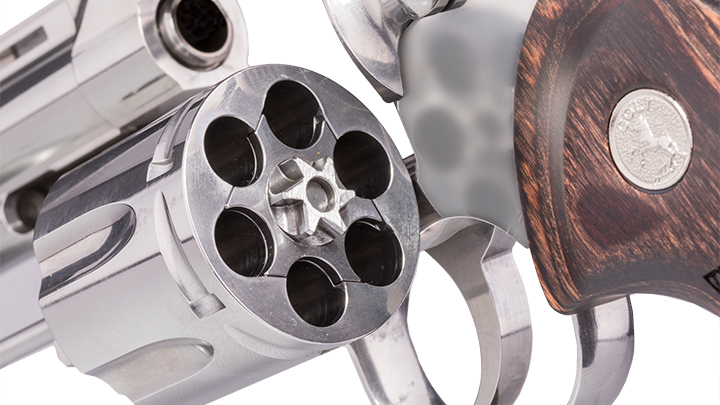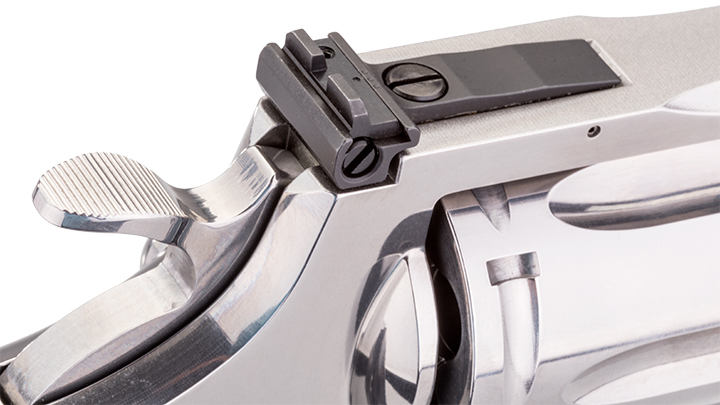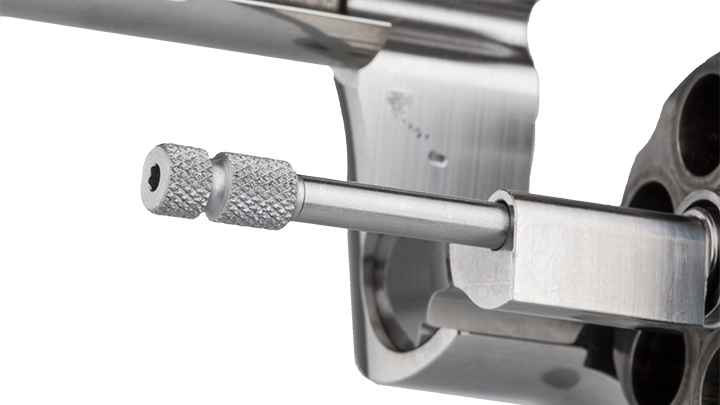
Not all handguns achieve the status of icon. Interestingly, the two most successful iconic handguns both came from Colt. They are the 1873 Peacemaker revolver and the 1911 semi-auto pistol. Both have stayed in production worldwide for well over 100 years with early models commanding impressive prices in the collectors’ market. Colt is betting that its Python revolver will achieve that same elite status. Terminating production has resulted in the price of original Pythons skyrocketing, and the company believes that reopening a production line with a more modern copy will ensure that the classy double-action revolver will ultimately pass the test of time.

An external inspection showed that the new stainless 6-inch Python is a close copy of the older model with the distinctive ventilated rib, full-length underlug and wide hammer spur. Fit and finish of the highly polished stainless-steel components are excellent with an attractive set of walnut grips that shame the chunky wood blocks furnished on the older, custom-fit Pythons. The large hammer spur has lateral serrations rather than the original checkered surface but was just as easy to thumb cock for single-action shooting. The crown is a recessed cut, as opposed to the original rounded muzzle shape on vintage guns, but appears to offer the same protection. The adjustable rear sight is mounted in a slot machined into the top of the frame while the front sight, with its new orange insert, fits into a slot at the muzzle end of the ventilated rib and features a set screw that allows the shooter to change blades if so desired. I prefer the black Eliason sights on my older Pythons for daylight hunting but will admit there is an advantage to the colored insert for possible defensive shooting.

The newer, slightly smaller walnut grips fit my hand much better than the original Python panels. Not perfect, but definitely better. It’s impossible for a factory gun to have a set of grips that will fit everyone, particularly on a revolver that may be fired both single- and double-action. That said, the newer grips allowed me to fire both single- and double-action with the kind of control that allows for rapid follow-up shots. The face of the narrow trigger features vertical serrations, kind of a compromise between a wide target trigger primarily meant for single-action shooting and a smooth narrow “combat” trigger meant for double-action shooting. I think it’s a reasonable compromise, at least for me, since I usually use revolvers of this length for hunting where a precisely placed first shot (where I cock the gun) is critical, but a fast follow-up shot (double-action) on wounded game can be important.

One of Colt’s major objectives in building the new Python was to make the gun more durable. Original Pythons had the reputation of shooting themselves loose and requiring tune-ups to reset timing and lockup. Internally, the newer models have been “beefed up” to withstand sustained use of heavy magnum loads. I’ve not run a torture test having fired no more than 300 magnum rounds, but I am impressed with how well the cylinder locks in place when the trigger is pressed. And while the .357 Magnum does not produce the brutal recoil of its big brothers, that 46 ounces of steel will make an extended shooting session much more pleasant, which equates to you becoming more proficient.
The only real issue I have with the new Python, or at least with my test gun, is the trigger pull. The Colt spec says the triggers leave the factory with a trigger pull between 7 and 9.5 pounds. The double-action pull on my gun averaged 10, pounds 9 ounces while the single-action pull measured 5 pounds, 13 ounces. Other new Pythons I’ve fired did come in under the 9.5-pound limit and felt good. And though the double-action trigger pull on this test gun felt even heavier than the more than 10 pounds it measured, it was the almost 6-pound single-action pull weight that bothered me more. With a reasonably steady rest on the range, I could muscle through the extra weight and still produce reasonable groups. Shooting offhand, a common experience in the field, I experienced some serious shakes before the hammer fell. Many of my personal revolvers have had their actions improved after purchase, and it’s not a particularly difficult or expensive job. But it’s not something one expects when purchasing a new revolver that’s billed as an improved replacement of the venerable Colt Python.

I’d have no qualms heading out for a hunt with a new 6-inch Python. Yes, on this particular gun I would get the trigger worked first, but keep in mind the big picture. The new Python is a good copy of the original with the internal structural improvements that should provide you and your kids years of service. And though many of us old-timers miss the beautiful blue finish of the originals, I know I was very careful regarding weather conditions when I ventured afield with my blued Pythons. The use of stainless steel in the new guns is authentic since Colt did offer the old guns in stainless. After your first hunting trip in wet weather, I think you’ll really appreciate the new heavy-duty models in stainless steel.

Technical Specifications
• Type: double-action revolver
• Caliber: .357 Mag.
• Capacity: 6 rnds.
• Barrel: 6" (tested), 4.25"; stainless steel; 6 grooves, 1:14" LH twist
• Trigger: 7-9.5-lb. pull weight (advertised, double-action)
• Sights: fully adjustable rear target, ramped front with interchangeable colored insert
• Grip: walnut target stocks
• Metal Finish: semi-polished stainless steel
• Overall Length: 11.5"
• Weight: 46 ozs.
• MSRP: $1,499; colt.com


































